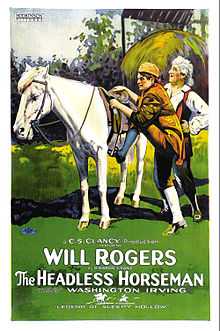The Headless Horseman (1922 film)
| The Headless Horseman | |
|---|---|

Film poster
|
|
| Directed by | Edward D. Venturini |
| Produced by | Carl Stearns Clancy |
| Written by | Washington Irving Carl Stearns Clancy |
| Based on | "The Legend of Sleepy Hollow" by Washington Irving |
| Starring | Will Rogers Lois Meredith Ben Hendricks Jr. |
| Cinematography | Ned Van Buren |
|
Production
company |
Sleepy Hollow Corporation
|
| Distributed by | W.W. Hodkinson Grapevine Video Reelclassicdvd.com Alpha Video Distributors Cinefear Finders Keepers Video |
|
Release date
|
November 5, 1922 |
|
Running time
|
68 minutes |
| Country | United States |
| Language | Silent (English intertitles) |
The Headless Horseman is a 1922 American horror film adaption of Washington Irving's The Legend of Sleepy Hollow starring Will Rogers, Lois Meredith (in her last major on-screen appearance), and Ben Hendricks Jr. that was directed by Edward D. Venturini. It was the first panchromatic black-and-white feature film.
The village of Sleepy Hollow is getting ready to greet the new schoolteacher, Ichabod Crane, who is coming from New York. Crane has already heard of the village's legendary ghost, a headless horseman who is said to be searching for the head that he lost in battle. The schoolteacher has barely arrived when he begins to pursue the beautiful young heiress Katrina Van Tassel, angering Abraham Van Brunt, who is courting her. Crane's harsh, small-minded approach to teaching also turns some of the villagers against him. Soon there are many who would like to see him leave the village altogether.
The unlikable, stern schoolmaster Ichabod Crane, who at one point beats a student, was played by Rogers, a popular actor playing against his typical roles for which he received $19,583.20. For authenticity, filming took place in the Hudson River Valley around Tarrytown, New York, the setting of Washington Irving's story, with its Dutch farm houses and covered bridges.The Headless Horseman was the first black-and-white feature film photographed entirely on panchromatic stock, which, while two to three times more expensive, did not have the tendency to turn blue eyes and skies white and lipstick as black like the commonly used orthochromatic film did. One effective special effect was the use of a double exposure to give the headless horseman a phantom-like appearance.
...
Wikipedia
